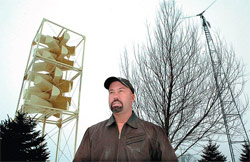The three blades of a traditional 120-foot wind turbine stood nearly still.
But a few yards away, Adam Fuller’s 36-foot wind tower turned silently in the breeze. The only sound came from a small chain around a sprocket—no louder than a bicycle.
Fuller, a Racine inventor who spent his life savings on the project (he is living in a motel to cut expenses), thinks he has developed a windmill design that could power the future.
“The concept is pretty basic,” Fuller said of his wind tower, which stands in Marlin Dunham’s backyard in rural East Troy. “What made sense to me is to create a design with a lot of surface area.
“That creates a more efficient machine by creating more drag on one side and an aerodynamic shape on the other side.”
Each of the eight stacked turbines has four wind scoops. The early prototype is half as tall as Fuller is permitted, but so far he is impressed. Since October, it has spun flawlessly and silently in the light breezes and sustained winds of 50 mph, he said.
“I have indications that it is going to work. It’s a good theory,” said Dunham, who powers his home and others with two traditional windmills and solar panels on his roof.
Easy energy
Fuller claims his patent-pending, all-steel design could be built for about $150,000 and pay for itself in four years with electricity savings and payments for supplying energy onto power grids.
If it ever is built to a height of 120 feet—about 50 feet higher than the 72-foot tower he is permitted now—he feels it could produce 30,000 to 75,000 kilowatt hours monthly, enough for 30 to 70 homes. Most homes use about 1,000 kWh per month.
Rational rotation
Traditional wind turbines, such as the ones proposed in Magnolia Township in Rock County, rely on wind glancing off a blade.
Fuller’s pinwheel-like design has more points of impact for the wind to strike. Even a slight breeze turns the blades and produces enough torque to spin a generator, he said.
“It’s a more efficient process. Think of a diesel engine. The load capability that a diesel engine can carry is much more than a gasoline engine, but it operates at a much lower RPM than a gasoline engine.”
Fuller thinks of himself more as an inventor than he does an environmentalist. He knew he could make the design and knows it can work.
Along the way, he realized his machine was virtually silent and harmless to birds.
The blades of traditional turbines can kill migratory birds, he said. His vertical design is a solid stack, easily avoided by birds.
“I’m going to change everything we know about alternative energy,” he said of the design.
An added benefit is having the generator at ground level, making maintenance easier. Even bearings high in the tower can be greased from the ground.
Roping the wind
Fuller hasn’t caught on yet with an investment group willing to finance mass production of his tower.
He has yet to hook up a generator to his unfinished prototype. He doesn’t have the money to buy one that can work on lower revolutions.
But he is hopeful there will be a market. He envisions thousands of “micro” wind farms with several towers on as little as 3 acres powering our future.
“I realize the situation that’s coming in 20 years, both with global warming and with current energy reserves,” he said. “It’s pretty alarming, when you do some thorough research, the situation that we’re going to be in if there isn’t some new technology introduced.”

 Adam Fuller believes his new windmill design could revolutionize wind power. Fuller says his design is more efficient and rotates in even the slightest breeze.
Adam Fuller believes his new windmill design could revolutionize wind power. Fuller says his design is more efficient and rotates in even the slightest breeze.
